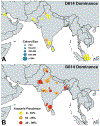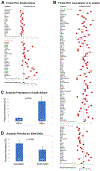The D614G Virus Mutation Enhances Anosmia in COVID-19 Patients: Evidence from a Systematic Review and Meta-analysis of Studies from South Asia
- PMID: 34533304
- PMCID: PMC8482322
- DOI: 10.1021/acschemneuro.1c00542
The D614G Virus Mutation Enhances Anosmia in COVID-19 Patients: Evidence from a Systematic Review and Meta-analysis of Studies from South Asia
Abstract
The prevalence of chemosensory dysfunction in patients with COVID-19 varies greatly between populations. It is unclear whether such differences are due to factors at the level of the human host, or at the level of the coronavirus, or both. At the host level, the entry proteins which allow virus binding and entry have variants with distinct properties, and the frequency of such variants differs between ethnicities. At the level of the virus, the D614G mutation enhances virus entry to the host cell. Since the two virus strains (D614 and G614) coexisted in the first six months of the pandemic in most populations, it has been difficult to distinguish between contributions of the virus and contributions of the host for anosmia. To answer this question, we conducted a systematic review and meta-analysis of studies in South Asian populations when either the D614 or the G614 virus was dominant. We show that populations infected predominantly with the G614 virus had a much higher prevalence of anosmia (pooled prevalence of 31.8%) compared with the same ethnic populations infected mostly with the D614 virus strain (pooled anosmia prevalence of 5.3%). We conclude that the D614G mutation is a major contributing factor that increases the prevalence of anosmia in COVID-19, and that this enhanced effect on olfaction constitutes a previously unrecognized phenotype of the D614G mutation. The new virus strains that have additional mutations on the background of the D614G mutation can be expected to cause a similarly increased prevalence of chemosensory dysfunctions.
Keywords: COVID-19; D614G virus mutation; SARS-CoV-2; South Asia; anosmia prevalence; olfactory dysfunction.
Conflict of interest statement
-
The authors have no conflicts of interest to declare.
Figures





References
-
- Mutiawati E, Fahriani M, Mamada SS, Fajar JK, Frediansyah A, Maliga HA, Ilmawan M, Emran TB, Ophinni Y, Ichsan I, Musadir N, Rabaan AA, Dhama K, Syahrul S, Nainu F, Harapan H. Anosmia and dysgeusia in SARS-CoV-2 infection: incidence and effects on COVID-19 severity and mortality, and the possible pathobiology mechanisms - a systematic review and meta-analysis. F1000Res. 2021. Jan 21;10:40. doi: 10.12688/f1000research.28393.1. - DOI - PMC - PubMed
Publication types
MeSH terms
Substances
Grants and funding
LinkOut - more resources
Full Text Sources
Medical
Miscellaneous

